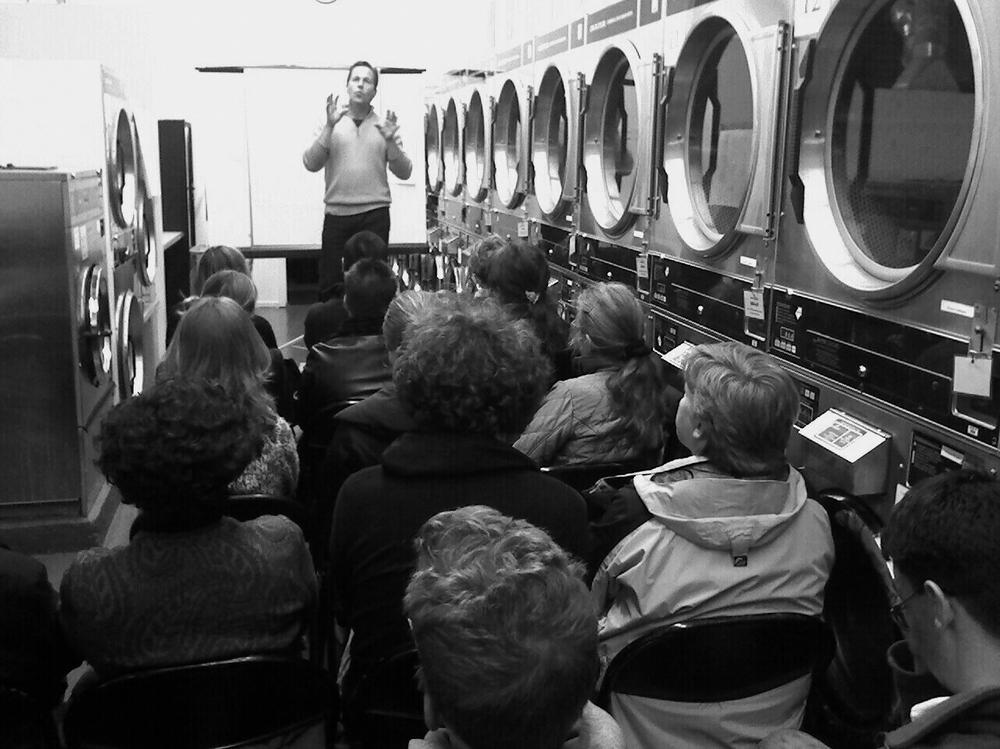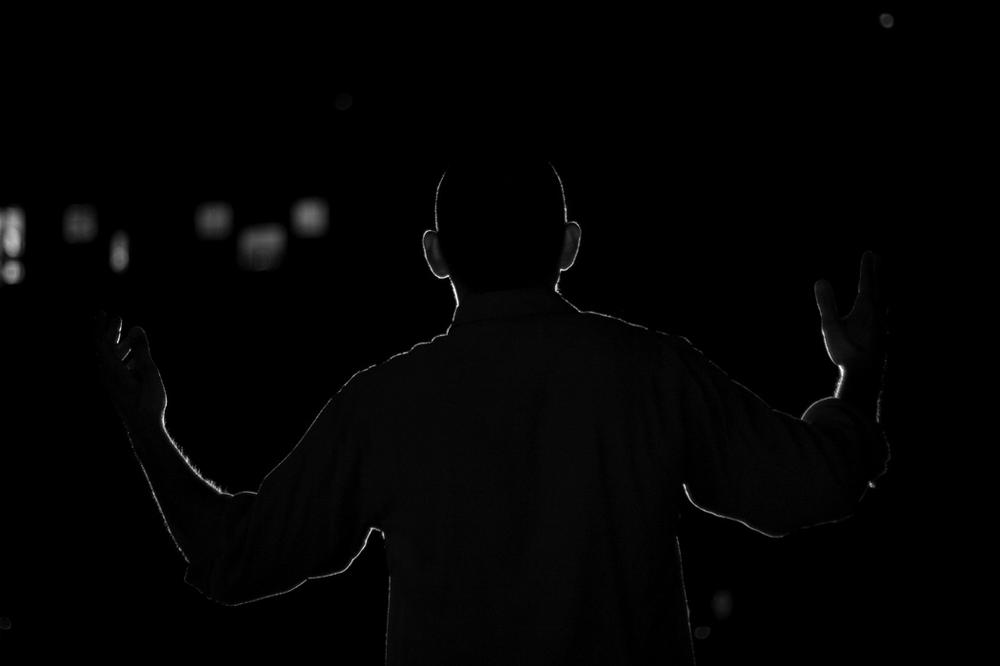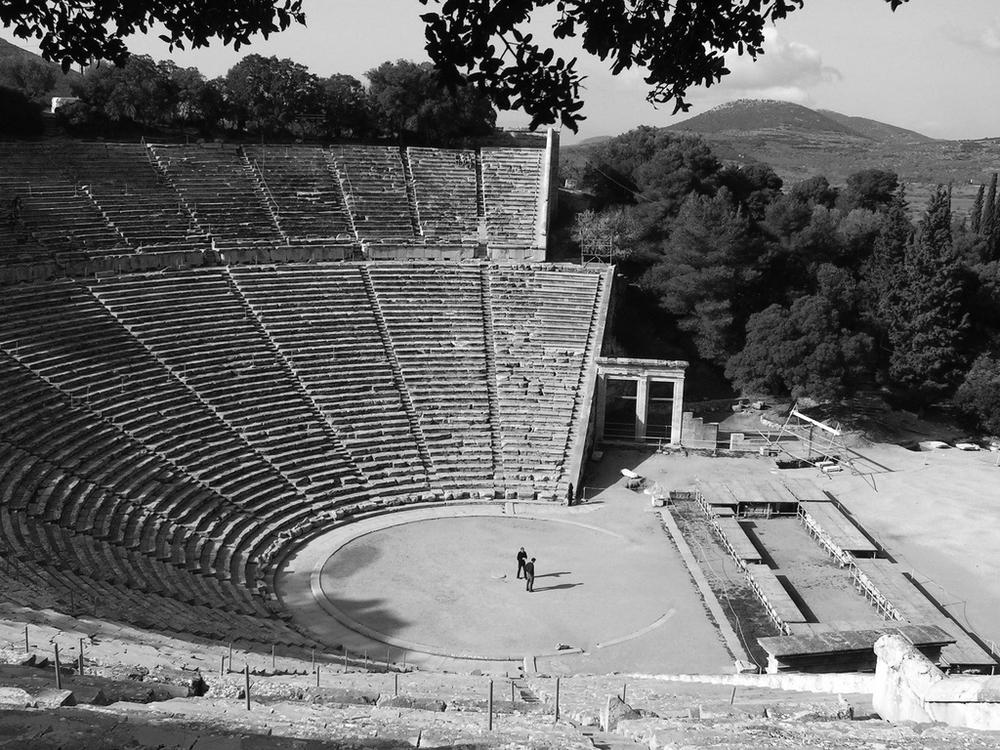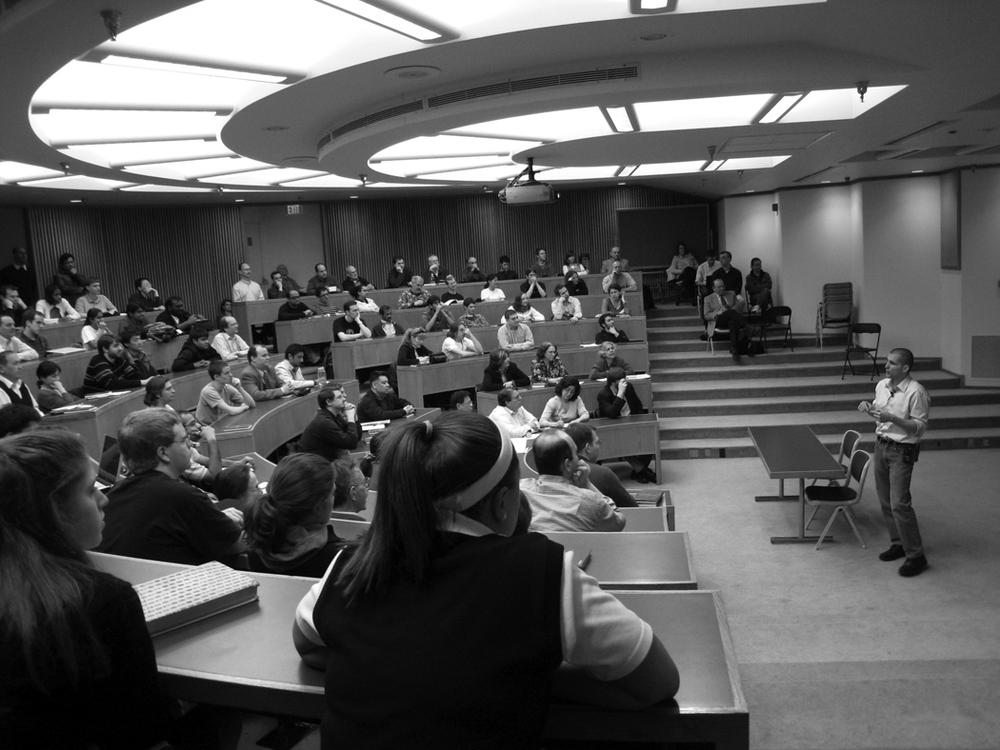Confessions of a Public Speaker (6 page)
Read Confessions of a Public Speaker Online
Authors: Scott Berkun
Tags: #BUSINESS & ECONOMICS / Skills


Half
of what you pay for at a fancy restaurant isn’t the food.
You’re paying its rent, you’re paying for the atmosphere, and you’re
paying for the way its service makes you feel. If you’ve ever taken a date
somewhere based on where it is, what it looks like, or how it feels to be
there, you know this is true. Public speaking is no different; the
atmosphere is important to the quality of everyone’s experience. If you
had to listen to Martin Luther King, Jr., in a New York City subway
station, or Winston Churchill in a highway rest stop bathroom, with all
the smells, noises, and rodents those atmospheric monstrosities are known
for, you’d be less than pleased. MLK’s most famous speech would go
something like this: “I have a…
eloquence would be no match for the unpleasant and distractive powers of
the environment around him.
Place
matters to a
speaker because it matters to the audience. Old theaters, a university
lecture hall, even the steps of the Lincoln Memorial are great places to
speak, but most speakers rarely get asked to do their thing
in venues this good. Most presentations are given under
flickering fluorescent lights inside cramped conference rooms, or in
convention halls designed with a thousand other functions in mind, which
explains why I know way more than I should about
chandeliers.
While you are in the audience looking up at the stage, a stage
designed to make me easy to see, often I can’t see anything (see
Figure 4-1
). All the house
lights are aimed right at my face. People forget that the room, as bad as
it might be, is set up to help the audience see, whereas we speakers are
on our own. Whenever you see pictures of a famous person giving a famous
lecture, you see the stage exactly the way the person with the best seat
in the house saw it. No one else is on stage, and if someone is, he’s not
moving around. If President Obama were giving a speech and a dozen people
behind him were eating cheeseburgers or playing charades, everyone in the
audience would be quite annoyed. But when I look out into the audience,
all I see are distractions. I can see and hear the back doors opening and
closing with every person arriving late or leaving early. I see the glow
of laptops in people’s multitasking eyes. I see cameramen and stage crews
moving heavy gear, flashing their lights, and making jokes, all in the
back rows behind the crowd, where only I can see. And most
depressing of all, on some days, the days I forget to make a
sacrifice to the gods of public speaking, all I can see when I look
straight ahead is the dizzying glare of the conference hall chandelier.
These are the cheap ones, made of grey metal, covered in chipping, peeling
gold paint. They hover in the space above the crowd, a place where few in
the audience ever look, but precisely where a speaker’s eyes naturally
want to go. In a good room, the ceiling is free of distractions; in a bad
room, there’s a large glowing ball of stupidity hanging there.

Figure 4-1. At a big event with stage lights. This gives an idea of what I
see: mostly nothing.
Disco balls work because they’re undeniably silly and make fun of
real attempts at decoration, but
chandeliers, even the cheap ones I often see, are entirely
serious. Despite their phony plastic flame-shaped light bulbs (who was
ever fooled by these?), they are a lame attempt to give a room class, a
kind of class that—to the disappointment of the owners of these
rooms—cannot be obtained by hanging something large and shiny from the
ceiling. I’m told these chandeliers are placed in conference halls for one
reason: weddings. They want to rent the room out for weddings—the highest
marked-up events in the Western world—and somehow without an ugly
chandelier in the brochure, they fear they’ll never be chosen as a wedding
venue again. Next time you’re at a lecture, check the ceiling. If you spot
a chandelier, know that it’s not there for you.
Why pick on a glorified light fixture? Why risk being
banned from speaking at chandelier-industry conferences for
the rest of my life? Here’s why. Presenters talk about “tough rooms” all
the time, usually referring to the audience. They blame the crowd when
they should first blame the
room
. Many challenges are created by
the room itself, challenges of atmosphere that change lukewarm crowds into
tough ones. Ever try to throw a birthday party in a graveyard or a funeral
in an amusement park? Of course not. You’d be set up to fail—unless your
family has handfuls of Xanex for breakfast or you’re related to Tim
Burton. Most venues for speaking and lecturing in the modern world are
dull, grey, uninspiring, poorly lit, generic cubes of space. They are
designed to be boring (which is why it’s hard to stay awake during
lectures) so they can be used for anything. And like a Swiss Army knife,
this means they suck at everything. Your average conference room or
corporate lecture hall is bought and sold for its ability to serve many
different purposes, though none of them well, which explains my unnatural,
and possibly deadly, level of exposure to
chandeliers. Blame speakers all you want—we do deserve most
of the blame—but some fraction of hate should go to whoever chose the
crappy room to stick the audience in. It’s not my choice. If I had my
choice, here’s where you’d see me (check out
Figure 4-2
).

Figure 4-2. The Greek Theater at Epidaurus.
I’d want to be at this Greek amphitheater, in part, because I hear
it’s quite nice in Greece, but mostly because the
ideal room for a lecture is a theater. It’s crazy, I know,
but we solved most lecture-room problems about 2,000 years ago. The Greek
amphitheater gets it all just about right, provided it doesn’t rain.
Lecture rooms should be a semicircle, not a square. The stage should be a
few feet higher than the front row, both to make people on the stage
e
asier to see, but also to help them feel powerful. And most
importantly, every row of seats should be higher off the ground than the
one before it, giving everyone a clear line of sight. All of these things
make it easier for the audience to stay interested and focus its attention
on center stage, as well as provide the speaker with natural
acoustics.
One of the best lectures I’ve given in recent memory was at Carnegie
Mellon University in the Adamson Wing, a theater-sized room that seats
maybe 120 (see
Figure 4-3
).
[
22
]
If you put a kegerator inside the lectern and added a
remote-controlled shock system that would electrify individual seats on
command (an anti-heckler device), it would be perfect.

Figure 4-3. The Adamson Wing at Carnegie Mellon University, a room designed
well for lectures.
And, of course, the most overlooked advantage of Greek-style
amphitheaters and good university lecture halls? No
chandeliers.
Theaters are rare. They cost more to build and to rent, and few
conference centers have them. When they do, they’re often reserved for the
big-name speakers on the schedule. Everyone else gets the square, dingy,
poorly lit loser
rooms. I speak in loser rooms all the time. But if you’re
invited to give a lecture and get a choice of rooms,
ask for the one that’s most theater-like. Even if it’s
smaller, even if it’s farther away, the room will score you extra points.
I get giddy all over when I know I’m speaking in a room set up to help me
connect
with the audience. A room free of poles and blind spots, a
room with good lighting, a room that’s soundproofed well enough so we
don’t hear the traffic outside or the lecture next door. It’s rare, but
when it happens, the people who hire me get their money’s worth.
In a square room, there are many
problems few talk about. If you’re in an aisle seat at the
far right or left of the room, staring straight ahead, you’ll be looking
at the front wall. To see what’s going on, you have to turn your head or
your body toward the center of the front. You also have to try and look
over or between the heads of the people in front of you—which if you’re
more than 20 rows back can be impossible. If you can’t see the speaker,
why are you there? You might as well watch the lecture on TV in the bar,
so you can play lecture drinking games with your friends, such as
“ummmster,” where you do a shot of your favorite cocktail every time the
speaker says “ummm.” With some speakers, you’ll be passed out in no
time.
If you’re in the audience, the angle of your body and the amount of
eye contact you make with the speaker might not seem to affect your
quality of experience, but for the speaker, it does. When 50, 100, or
5,000 people can give 10% more of their attention and energy to
you—whether through their eye contact, posture, or laughter—it makes the
difference between feeling confident and feeling lost. One extra pair of
friendly eyes, or the visibility of an affirmative nod now and then,
changes how any speaker feels. And in a good room—whether you’re at a
concert or presentation—energy moves easily between the crowd and the
stage.
Even in bad clubs, musicians have many advantages for controlling
the energy in a room—bass drums and amplified guitars literally force
waves
of energy to bounce around, getting people to dance or
respond in various other ways. But in a grey, boring square room of right
angles on top of right angles—where half the crowd mostly sees the bald
spots in the hairlines of the people sitting in front of them, and where
instead of a bass drum, they hear the whiny voice of, for example, the
head of accounting droning on about the right way to fill out page 9,
section F of the new expense reports—the energy in the room is split and
fractured well before it leaves the stage. It bounces around, gets eaten
by the walls, drained by the dull carpet, smothered by the dim lights, and
dies. A speaker, unarmed
with a guitar or bongos, is on his own to overcome the
deficiencies of the space. Even good speakers are frequently eaten alive
by the effects of bad rooms.
